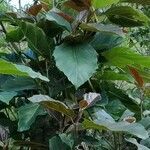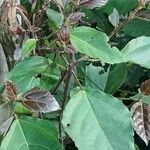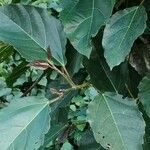Small trees, evergreen; dioecious. Bark dark brown. Branchlets hispid. Stipules ovate-lanceolate, 1-2 cm. Leaves alternate; petiole (0.7-)1.5-4 cm; hispid or hirsute; leaf blade obovate to oblong, 10-20 × 4-8 cm, papery, abaxially sparsely pubescent or yellow tuberculate, adaxially glabrous, base obliquely cuneate to rounded, margin entire or undulate, apex mucronate; basal lateral veins short, secondary veins 6-9 on each side of midvein. Figs on short ± conic branchlets on main branches, reddish orange when mature, ± globose, 1.5-2 × 1.5-2.2 cm, subglabrous, smooth, apical pore not open; peduncle (0.5-)0.8-2.4 cm. Male flowers: few, near apical pore, shortly pedicellate; calyx lobes 3 or 4; stamen 1; filament short. Gall flowers: pedicellate; calyx lobes very short or absent; ovary obovate, smooth; style ± lateral, thin; stigma enlarged. Female flowers: perianth tubular, enclosing base of pedicel; style persistent, long, clavate. Achenes obliquely cubic, with small tubercles. Fl. May-Jul.
A fig. It is a small tree. It is evergreen. It is 10-15 m high. The trunk is 15-30 cm across. The sexes are separate. The bark is dark brown. The small branches are coarse. The leafy structures near the base of the leaves are oval and about 1.7 cm long. The leaf stalk is 1.5-4 cm long. The leaves are alternate. The leaf blade is oblong and 10-20 cm long by 4-7 cm wide. They are papery. They are slightly hairy underneath. The base is wedge shaped but unequal. The tip is sharp. The figs are in clusters on small outgrowths from old stems. They are orange red when mature and round but flattened. They are 1.5-2 cm across. They are smooth. The stalk is 0.8-2.4 cm long. Male and gall flowers are in the same fig with the male flowers near the opening.




